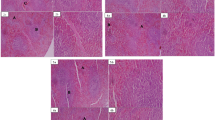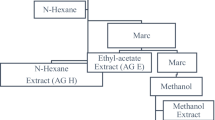Abstract
Plants and plant extracts are used extensively to treat many diseases. Fumaria officinalis is an annual plant from the genus Fumaria which has long been used in herbal medicine. The aim of this study was to examine the haematological effects of F. officinalis hydroalcoholic extract in rabbits. This study was conducted over a period of 28 days. Two doses of F. officinalis hydroalcoholic extract (200 and 400 mg/kg body weight) were administrated orally to two groups of rabbits. Parameters evaluated included packed cell volume (PCV), Hb, mean corpuscular volume (MCV), RBC and total and differential WBC count. The results showed that F. officinalis hydroalcoholic extract (FOHE) produces a non-dose-dependent significant (P < 0.05) decrease in PCV, Hb, MCV, RBC, total WBC and neutrophil percentage in the two experimental groups when compared with the control group. However, it increased lymphocyte, eosinophil and monocyte percentages. In conclusion, FOHE reduces haematological activity in rabbits which should warrant its consideration in the management of anaemia and immunity-dependent disorders.
Similar content being viewed by others
References
Adeneye AA (2008) Haematopoetic effect of methanol seed extract of Citrus paradisi Macfad (grape fruit) in Wistar rats. Biomed Res 19(1):23–26
Amin GH (1991) Popular medical plants of Iran. Farhang Press, Tehran, pp 51–52
Attard E, Cuschieri A, Scicluna-Spiteri A, Brincat MP (2004) The effects of cucurbitacin E on two lymphocyte models. Pharm Biol 42(2):170–175
Attard E, Brincat MP, Cuschieri A (2005) Immuno-modulatory activity of cucurbitacin E isolated from Ecballium elaterium. Fitoterapia 76:439–441
De Gruchy GC (1976) Clinical haematology in medical practice. Blackwell Scientific Publication, Oxford, London, pp 33–57
De Smet PAGM (1995) Health risk of herbal remedies. Drug Saf 13(2):81–93
De Smet PAGM (1997) Adverse effects of herbal remedies. Adverse Drug React Bull 183:695–698
Fitter R, Fitter A, Blamey M (1974) The wild flowers of Britain and Northern Europe. Collins, London, p 78
Gharib Naseri MK, Mazlomi H, Goshaiesh M, Vakilzadeh G, Heidari A (2006) Antispasmodic effect of Zataria multiflora Boiss leaf extract on the rat uterus. Iran J Pharma Res 5:131–136
Guyton AC, Hall JE (2006a) Resistance of the body to infection: II. Immunity and allergy. In: Guyton AC, Hall JE (eds) Textbook of medical physiology, 11th edn. Saunders Publishers, Philadelphia, p 440
Guyton AC, Hall JE (2006b) Resistance of the body to infection: I. Leukocytes, granulocytes, the monocyte-macrophage system, and inflammation. In: Guyton AC, Hall JE (eds) Textbook of medical physiology, 11th edn. Saunders Publishers, Philadelphia, pp 431–434
Hentschel C, Dressler S, Hahn EG (1995) Fumaria officinalis (fumitory)—clinical applications. Fortschr Med 113(19):291–292
Howard M (1987) Traditional folk remedies. Century, London, pp 142–3
Jain NC (1986) Schalm's Veterinary Hematology, 1st edn. Lea & Febiger, Philadelphia, pp 25–29
Khalilighi-Sigaroodi F, Yazdani D, Taghizadeh M, Rezazadeh S (2005) Quantities determination of an effective component of Fumaria parviflora Lam. J Med Herb 4:62–71
Lowenthal JW, Connick T, McWater PG, York JJ (1994) Development of T cell immune responsiveness in the chicken. Immunol Cell Biol 72:115–122
Mortazavi SR, Nassiri-Asll M, Farahani-Nick Z, Savad S, Farzam SK (2007) Protective effects of Fumaria vaillantii extract on carbon tetrachloride induced hepatotoxicity in Rats. Pharmacol Online 3:385–393
Norusis MY (1993) SPSS for windows base system user’s guide release 6.0, 1st edn. SPSS Inc, Michigan, pp 281–290
Ozougwu JC (2011) An investigation of the effects of Allium sativum (Garlic) extracts on hematological profile of white albino rats. Pharmacol Online 2:299–306
Polenakovic M, Sikole A (1996) Is erythropoietin a survival factor for red blood cells? J Am Soc Ephrol 7(8):1178–1182
Saba AB, Oridupa OA, Ofuegbe SO (2009) Evaluation of haematological and serum electrolyte changes in Wistar rats administered with ethanolic extract of whole fruit of Lagenaria breviflora Robert. J of Med Plants Res 3(10):758–762
Sanchez-elsner T, Ramirez RJ, Rodrignezsanz F, Varela E, Bernabew C, Botella LM (2004) A cross talk between hypoxia and tgf-beta orchestrates erythropoietin gene regulation through sp and smads. J Mol Biol 36(1):9–24
Sharma UR, Prakash T, Surendra V, Roopakarki N, Goli D (2012) Hepatoprotective activity of Fumaria officinalis against CCL4–induced liver damage in rats. Pharmacologica 3(1):9–14
Shaw D, Leon C, Kolev S, Murray V(1991–1995) Traditional remedies and food supplements: a 5-year toxicological study. Drug Saf 17:342–536
Tomori OA, Saba AB, Dada-Adegbola HO (2007) Antibacterial activity of ethanolic extract of whole fruit of Lagenaria breviflora Robert. J Anim Vet Adv 6(5):752–757
Vrba J, Vrublova E, Modriansky M, Ulrichova J (2011) Protopine and allocryptopine increase mRNA levels of cytochromes P450 1A in human hepatocytes and HepG2 cells independently of AhR". Toxicol Lett 203(2):135–141
Zargari A (1989) Medicinal plants. Tehran University Press, Tehran, pp 170–171
Author information
Authors and Affiliations
Corresponding author
Rights and permissions
About this article
Cite this article
Khoshvaghti, A., Derakhshanian, S., Zamanzadeh, A. et al. The effects of Fumaria officinalis hydroalcoholic extracts on haematological profile of New Zealand rabbits. Comp Clin Pathol 23, 869–873 (2014). https://doi.org/10.1007/s00580-013-1705-9
Received:
Accepted:
Published:
Issue Date:
DOI: https://doi.org/10.1007/s00580-013-1705-9




